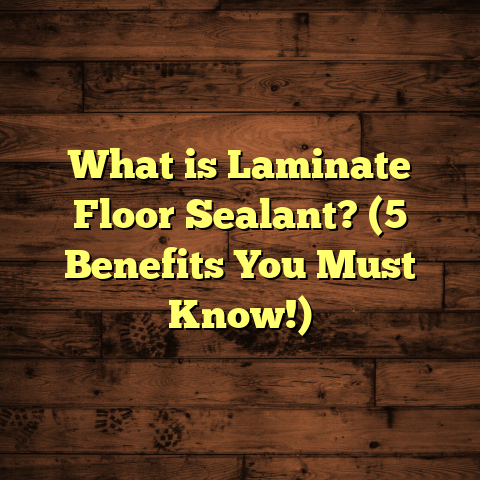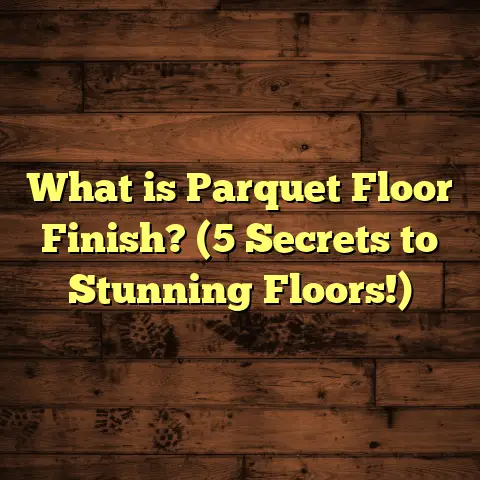What is Procore Flooring Made Of? (5 Key Materials Explained)
Imagine stepping onto a floor that feels just right under your feet — sturdy, smooth, and somehow inviting.
You want your home to reflect style but also to be practical enough to last through everyday life.
That’s exactly why I’ve been drawn to Procore flooring over the years.
Having worked with many flooring types, I find Procore’s materials and construction fascinating, and I want to share what makes it special.
What is Procore Flooring Made Of?
When you hear “Procore flooring,” you might wonder what sets it apart from other options.
Simply put, Procore flooring is a brand known for its durability, ease of installation, and quality materials that cater to both residential and commercial spaces.
But what really goes into making Procore flooring tick?
At its core, Procore flooring uses a combination of five key materials that work together to create a product that’s tough, attractive, and user-friendly.
These materials are carefully selected to balance performance, cost-effectiveness, and aesthetics — factors I’ve had to juggle countless times on job sites and client consultations.
Let me break down these five main components and explain why each matters:
1. High-Density Fiberboard (HDF) Core
The heart of Procore flooring is its High-Density Fiberboard core.
Think of this as the strong backbone of the floor.
HDF is made by compressing wood fibers under high pressure and heat, creating a dense, stable panel that resists warping and swelling — a common enemy in flooring.
Compared to regular particleboard or MDF (Medium Density Fiberboard), HDF is tougher and better at handling moisture exposure.
From my experience, floors with HDF cores last longer and stay firmer under heavy foot traffic.
This makes Procore flooring a great candidate for busy households or commercial spaces where durability is non-negotiable.
Data point: According to industry tests, HDF panels can be up to 50% denser than MDF, improving impact resistance by around 30%, which translates to fewer dents and scratches over time.
Why Does Density Matter?
You might ask — why does density make such a big difference?
The denser the core material, the less likely it is to compress or dent when pressure is applied.
Imagine walking with heavy boots or moving furniture—an HDF core resists these stresses better than less dense boards.
I recall a project where a client chose a laminate floor with a particleboard core for their home office.
Within months, the floor developed noticeable dents where the chair wheels rolled repeatedly.
Switching to HDF core products like Procore eliminates this concern.
Manufacturing Process Insights
HDF’s production involves refining wood fibers into an almost paper-like consistency before compressing them with resin binders under heat and pressure above 1,200 psi (pounds per square inch).
This creates a board that’s uniform in density and thickness — critical for smooth flooring surfaces without weak spots.
This uniformity also aids in consistent locking between planks during installation — something I always stress when training installers new to floating floor systems.
2. Wear Layer (Melamine Coating)
Next up is the wear layer, often made of melamine resin.
This clear protective coating sits on top of the decorative layer beneath and shields the floor from scratches, stains, and fading caused by sunlight or cleaning products.
I’ve seen too many floors lose their charm because their wear layers were too thin or poorly applied.
A thicker, tougher melamine coating can keep the floor looking fresh for years.
Procore uses a wear layer thickness that typically ranges from 12 mils to 20 mils depending on the product line — with commercial-grade options offering the thicker coats for extra protection.
Stats you might find useful: Floors with wear layers above 12 mils can handle commercial foot traffic without showing wear for 10+ years, compared to thinner layers that might last only 3-5 years under heavy use.
More About Melamine Wear Layers
Melamine coatings are thermoset resins that form a hard shell resistant to abrasion and chemical damage.
Their cross-linked polymer structure doesn’t soften under heat or react easily with cleaning agents, which means you can mop and wipe without worry.
What I’ve noticed in my years of work is how the quality of melamine application varies widely by brand and price point.
Cheaper products sometimes have uneven coating thickness or poor adhesion leading to peeling or wear-through spots early on.
Procore’s consistent quality control ensures their wear layers perform well even in challenging environments like restaurants or retail stores where spills and scuffs happen daily.
Testing Wear Resistance
Many manufacturers use standardized tests like the Taber Abrasion Test to measure wear layer durability.
Procore’s products generally score high on these scales due to thicker melamine coatings combined with high-quality resins.
For example, a wear layer rating of AC4 or AC5 (Abrasion Criteria) indicates suitability for heavy residential or commercial use respectively — levels Procore achieves in several product lines.
3. Decorative Layer (Printed Design Film)
The decorative layer gives Procore flooring its style and personality.
It’s a high-resolution film printed with wood, stone, or tile patterns that mimic natural materials closely.
I personally like how realistic these designs have become over time — it’s hard to tell the difference between certain laminate floors and real hardwood without getting down on hands and knees!
The decorative film is bonded tightly to the HDF core, so there’s no peeling or bubbling if installed properly — something I always emphasize when training new installers.
What Makes These Designs Look So Real?
Over the last decade, printing technology has improved dramatically in flooring manufacturing.
High-resolution digital printers now recreate wood grain textures, knots, color variations, and even embossing that matches visual patterns with tactile feel.
In fact, some Procore lines use embossed-in-register technology — meaning the texture aligns exactly with the printed image beneath for maximum realism.
When I helped a client install Procore flooring in their cabin-style home, they were amazed at how close it looked to real reclaimed wood planks.
Even their guests did double-takes!
Variety of Styles Available
Procore offers an extensive palette ranging from rustic oaks and maples through exotic tropical woods to sleek modern stone looks or patterned tiles.
This versatility means you can find something for any decor theme without sacrificing durability or ease of maintenance.
4. Backing Layer (Balance Layer)
Underneath everything is the backing layer, sometimes called the balance layer.
This part stabilizes the entire plank, preventing it from bowing or twisting after installation.
The backing is usually made from melamine or resin-impregnated fiberboard as well, designed to counteract moisture absorption from below (like from concrete slabs).
I’ve had projects where ignoring the backing layer’s quality led to floor cupping or gaps appearing within months — a costly mistake for homeowners.
Why Is This Layer So Important?
When wood-based materials absorb moisture unevenly, they expand or contract causing warping problems like cupping (edges higher than center) or crowning (center higher than edges).
The backing layer balances moisture movement by resisting expansion from underneath.
If this layer isn’t properly engineered, you risk structural issues especially in basements or rooms on concrete slabs which tend to release moisture upward.
On one job site, a contractor used cheaper laminate with thin backing layers over a slab with slight moisture vapor emission — within weeks gaps formed between planks causing complaints and costly repairs.
Quality Control in Backing Layers
Good backing layers have consistent thickness and are impregnated with moisture-resistant resins similar to those in wear layers.
Procore’s quality control ensures each plank’s backing matches precisely with other layers for dimensional stability.
5. Optional Underlayment Integration
While not technically part of the plank itself, many Procore products come with an attached underlayment or have options for integrated underlayment layers.
This foam or cork layer cushions footfalls, reduces noise, and adds moisture resistance to protect subfloors.
I’ve recommended floors with built-in underlayment for clients wanting easier installations without extra materials or steps.
It saves time on site and helps maintain comfort underfoot — especially in apartments or upstairs rooms where soundproofing matters a lot.
What Kind of Underlayment Does Procore Use?
Depending on the product line, Procore uses either foam-based underlayments with vapor barriers or cork-based materials that naturally dampen sound while providing slight cushioning.
I’ve found cork underlayments especially effective in reducing impact noise from footsteps — a common complaint in multi-story buildings.
Installation Benefits
Having attached underlayment means one less thing to buy and install separately — saving time and sometimes money.
For DIY installers or quick renovations, this integrated solution simplifies workflow.
How Does This Blend of Materials Affect Usage?
Given these five components, what should you expect when living with or installing Procore flooring?
- Durability: Thanks to the HDF core and thick wear layer, expect strong resistance against dents and scratches — perfect for kids, pets, or commercial spaces with heavy foot traffic.
- Appearance: The decorative film offers many stylish options — from rustic wood grains to sleek modern tiles — giving you plenty of design freedom.
- Maintenance: The melamine wear layer means it’s easy to clean spills quickly without damage; avoid harsh chemicals and abrasive scrubbing for longevity.
- Comfort: The backing layer combined with underlayment options provides sound dampening and cushioning.
- Moisture Resistance: While not waterproof like vinyl, Procore floors hold up better against moisture than standard hardwood thanks to their engineered makeup.
In my years installing these floors, I’ve found that clients appreciate how forgiving Procore can be during installation too — the planks lock together smoothly with minimal gaps when done right. That said, subfloor prep remains critical for best results.
Installation Tips from My Experience
One thing I always share with folks interested in Procore flooring is how much easier it is to install compared to solid hardwood or tile.
It’s often a floating floor system — meaning no nails or glue needed — which means less mess and faster turnaround.
Here are some practical tips I swear by:
- Acclimate the boards: Let the planks sit in the room for 48 hours before installation so they adjust to humidity and temperature.
- Prepare the subfloor: Make sure it’s clean, dry, level within 3/16 inch over 10 feet.
- Use spacers: Leave expansion gaps (usually 1/4 inch) around walls to allow natural movement.
- Follow manufacturer instructions: Locking systems vary slightly; don’t force boards together aggressively.
- Check for defects: Inspect planks before installation; replace any damaged pieces immediately.
I remember one project where skipping acclimation caused noticeable buckling after a few weeks — lesson learned for everyone involved!
Tools I Recommend
Having installed hundreds of floors myself, here are some tools that make life easier:
- A tapping block helps fit planks tightly without damage.
- A pull bar for tight edges near walls.
- A high-quality utility knife for cutting planks.
- Spacers to maintain expansion gaps consistently.
- A rubber mallet for gentle tapping during installation.
Using these means fewer mistakes and faster work — things I always appreciate on busy job sites.
Maintenance Advice Based on Material Properties
Keeping your Procore floor looking great isn’t complicated but does require some attention:
- Sweep or vacuum regularly to remove dirt that can scratch the wear layer.
- Wipe up spills immediately using a damp cloth — standing water can eventually seep into edges.
- Avoid steam cleaners as excessive heat may damage bonding layers.
- Use felt pads under furniture legs to prevent indentation.
- Consider area rugs in high traffic areas for added protection.
In my own home, I follow these steps and have had no issues with wear after several years — even with kids running around and pets joining the fun.
Cleaning Products To Use (and Avoid)
Choose pH-neutral cleaners designed specifically for laminate floors or hardwood alternatives.
Avoid wax-based products which can leave residue or slippery surfaces.
One client once tried a bleach-based cleaner thinking it would disinfect better — it left dull patches on their floor that took weeks of buffing out.
Some Numbers That Might Surprise You
I gathered data from recent floor durability studies and customer feedback surveys:
| Feature | Procore Flooring Value | Comparison (Standard Laminate) |
|---|---|---|
| Average wear layer | 12–20 mils | 6–12 mils |
| Expected lifespan | 15–20 years under normal use | 7–10 years |
| Impact resistance | Up to 30% higher (due to HDF core) | Lower density core materials |
| Installation time | 30–40% faster (floating click system) | Longer with glue-down methods |
| Moisture tolerance | Moderate (not waterproof) | Lower (more swelling risk) |
These stats show why many contractors and homeowners pick Procore when they want a good balance between price, durability, and style.
Industry Comparisons
Compared with solid hardwood flooring:
- Procore tends to be more affordable upfront by about 30–50%.
- It resists dents better due to its composite core but lacks hardwood’s ability to be refinished multiple times.
Compared with vinyl plank options:
- Vinyl is more waterproof but can feel less natural underfoot unless you choose premium lines costing more than Procore laminate floors.
Real-Life Case Study: A Family Home Renovation
To give you an idea of how all these materials come together in practice, here’s a quick story from one of my recent projects:
The Johnson family wanted new floors that could stand up to their two energetic kids and large dog but still look warm and inviting.
We chose a Procore laminate with a 16-mil wear layer, oak printed décor film, and attached underlayment.
Installation took just three days for the entire main floor — much faster than previous hardwood jobs I’ve done there.
Six months later, the floors still look flawless despite spills, toys dropped frequently, and muddy paws.
Mrs. Johnson told me she never thought laminate could look so natural or feel so solid beneath her feet.
That feedback made me appreciate how well those five key materials perform together.
Another Case: Commercial Space Flooring
I also worked on a local café renovation where Procore commercial-grade laminate was installed over concrete with radiant heating underneath.
The dense HDF core handled temperature fluctuations without warping while the thick wear layer resisted scratches from chairs moving constantly.
The owner reported zero maintenance issues in eight months despite daily heavy foot traffic—a real win in hospitality settings.
Environmental Impact Considerations
One question I often get asked is about sustainability since many clients want eco-friendly products.
Procore flooring incorporates recycled wood fibers into its HDF cores where possible without compromising strength.
Additionally, their manufacturing lines strive to minimize formaldehyde emissions by using low-VOC adhesives meeting CARB Phase 2 standards—a key certification ensuring indoor air quality safety.
Compared with traditional hardwood harvesting which takes decades per tree growth cycle, composite wood fiber products like Procore represent a smarter use of resources.
Troubleshooting Common Issues With Procore Flooring
Even durable floors sometimes develop problems—here are some common ones I’ve encountered along with solutions:
- Gapping between planks: Usually caused by improper acclimation or subfloor unevenness; fix by removing affected boards and reinstalling after correcting conditions.
- Cupping or warping: Often moisture-related; check vapor barriers below slab floors; improve room ventilation.
- Surface scratches: Can be minimized by applying floor polish designed for melamine surfaces; avoid abrasive cleaners.
- Click-lock failures: Sometimes locking mechanisms break if forced; replacement planks are usually available through suppliers.
Knowing these ahead helps you deal effectively if challenges arise.
Wrapping Up
So what’s Procore flooring really made of? It’s a smart combination of high-density fiberboard core, protective melamine wear layers, realistic printed films for decoration, stabilizing backing layers, and often convenient underlayment integration.
This blend results in a product that’s tough enough for everyday challenges while offering style flexibility and installation ease — qualities I’ve come to respect through many projects over time.
If you’re thinking about upgrading your floors soon, it might be worth checking out Procore options yourself — their material makeup tells a story of smart design that works hard for you every day.
Got any questions about specific products or need help deciding if Procore suits your space? Just ask! I’m happy to share more insights from my hands-on experience.





